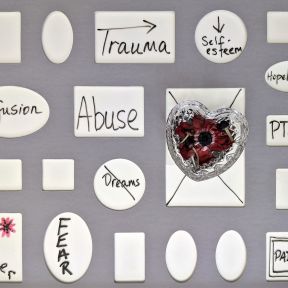
Trauma Bonding
A trauma bond is an emotional attachment that can form in an abusive relationship, specifically the connection the victim feels toward the perpetrator.
A trauma bond is characterized by cycles of negative reinforcement interspersed with occasional bursts of positive reinforcement; this so-called intermittent reinforcement makes it very difficult to leave an abusive relationship. But with support, healing is always possible.
Colloquially, people may use the term trauma bonding to refer to something else—the concept of connecting with someone by revealing a personal trauma. This meaning may be used conversationally, but the term here refers to forming an emotional attachment in an abusive relationship.

A trauma bond in a relationship involves a foundation of abuse, which may hinge on tactics such as threats of harm, manipulation, control, shaming, gaslighting, and sabotage, mixed with intermittent moments of calm and displays of affection. This pattern of highs and lows increases a victim’s unhealthy attachment to the abuser, which helps maintain the relationship.
The signs of being trauma-bonded include:
• You realize you don't like the person. For example, you may feel angry toward them but know it's unsafe to express your feelings. You may have physical reactions to being near the person or having them touch you.
• Your relationship is built around guilt and shame. Abusive people leverage fear, obligation, and guilt. If you speak up for your needs, you are told you are selfish and demanding.
• You're not sure you'd leave if the abuse increased. The longer you’re with an abusive person, the more abusive behavior is normalized.
• You are love bombed and then devalued. There may be an extreme push-pull cycle. You go from being someone who can "do no wrong" to someone who can "do no right."
• You are hypervigilant. You have the feeling of “walking on eggshells.”
People in a trauma bond may find themselves unable to leave the relationship, and some may realize they choose abusive partners again and again. One reason why it can be so difficult for people to leave involves intermittent reinforcement. The cycle of trauma bonding includes repeated abuse with occasional moments of being “loved” or “saved.” The brain may latch onto the positive experience of relief and safety and aim to achieve it again during the next cycle of abuse.
Research has long demonstrated that intermittent reinforcement is a powerful force. For example, slot machines and other forms of gambling leverage this psychological concept to make people spend more money.
Trauma bonding is thought to occur in seven stages. These are:
1. Love bombing
2. Gaining trust
3. Criticism
4. Manipulation
5. Resignation
6. Distress
7. Repetition
Personal risk factors for trauma bonding may include:
• A family history of mental health problems
• Limited social support
• An insecure attachment style
• Poor or insufficient coping strategies
• A history of being bullied or harassed
• A prior history of trauma
• Substance abuse or addiction
• Absentee or negligent parenting
• Identity disturbances
• Narcissistic parenting
• Mental health conditions such as depression, anxiety, PTSD, and borderline personality disorder
Trauma bonding may be rooted in a traumatic bond with a childhood caregiver. Trauma bonding occurs primarily because there is no other option for attachment. People who are drawn to relationships that are abusive or dissatisfying in nature have often experienced connections that didn’t feel emotionally safe or stable in their early development.
Stockholm syndrome is an example of a trauma bond; trauma bonding is the broader term that encompasses Stockholm syndrome. The term comes from a 1973 bank robbery in Stockholm, Sweden, in which the perpetrator kidnapped four hostages who were thought to have developed an emotional attachment to the perpetrator and refused to speak out against him. Today, the term still refers to forming an attachment to a captor, kidnapper, or abuser.

A trauma bond can significantly damage one’s mental, emotional, and physical health. Cycles of intermittent positive and negative reinforcement make it extremely hard to walk away from these relationships.
Therefore, healing from a traumatic bond requires a comprehensive approach to intervention. Clinicians can educate patients on how traumatic bonds are formed and maintained, as well as provide concrete goals that help patients establish a safety plan, build self-reliance, establish firm boundaries, and increase their autonomy so they can begin to heal.
It’s very difficult to try and change the underlying dynamics of an abusive relationship. Therefore, an effective way to free yourself from a trauma bond is to make the decision to have no contact or low contact with the other person. This can be a complex process that requires deep thought and strong support. A mental health professional can assist you through that process. Support groups, such as intimate partner violence support groups, can be important and helpful as well.
One key mindset shift is learning to accept and love yourself rather than relying on someone else to love you. People in a trauma bond may be waiting for their partner, family member, or loved one to finally see their worth and love them. But this is part of the cycle of a trauma bond, so an important skill in separating yourself is learning not to wait for others but to love yourself. Working with a trauma-informed therapist can help with this process.
Abusive relationships can deteriorate self-esteem. Instead of being harsh on yourself, self-compassion can help you heal. Speaking positively to yourself, as well as exercise, healthy food, and spending time in nature can provide the baseline for developing self-compassion yourself or with a therapist. Engaging in these forms of self-care can help you feel good and reinforce the idea that you don’t need to be dependent on others to be happy.













